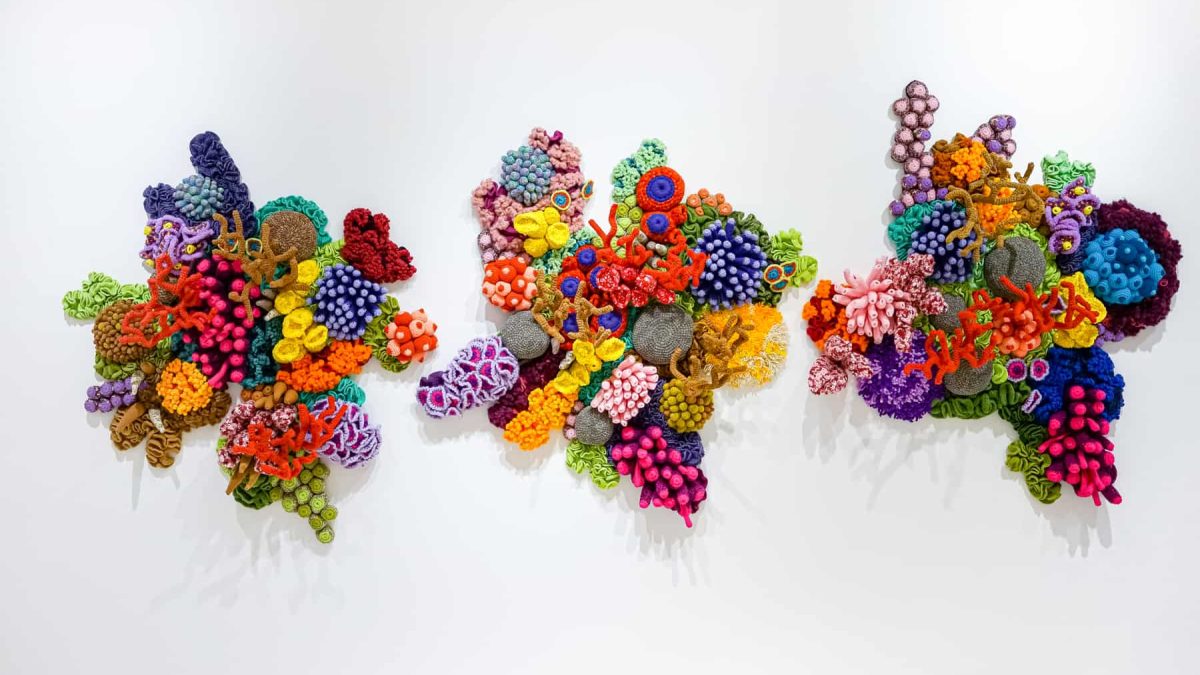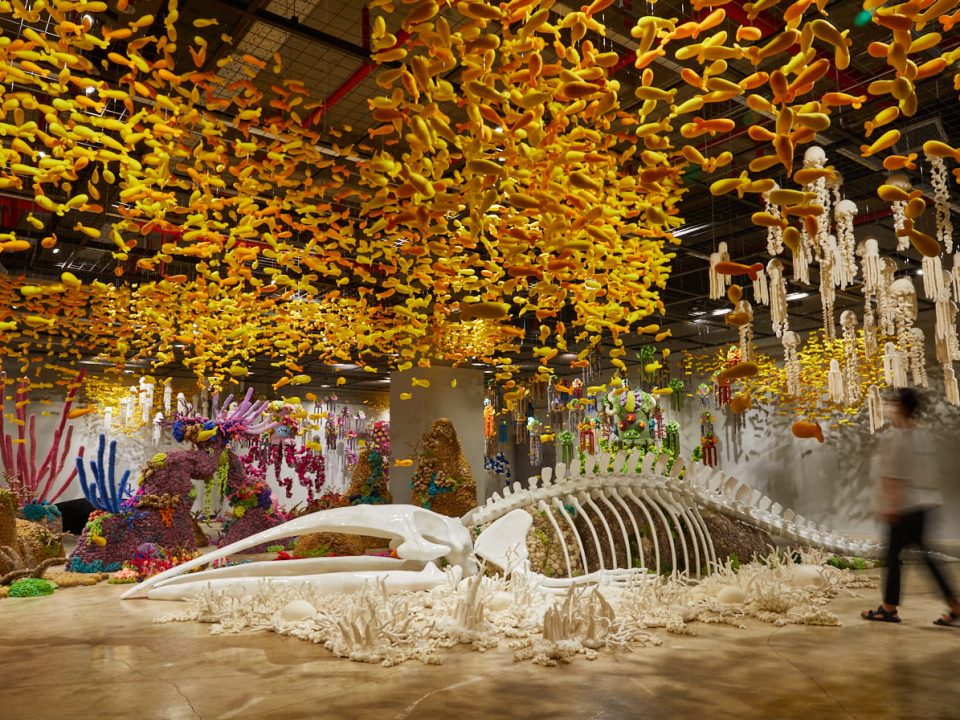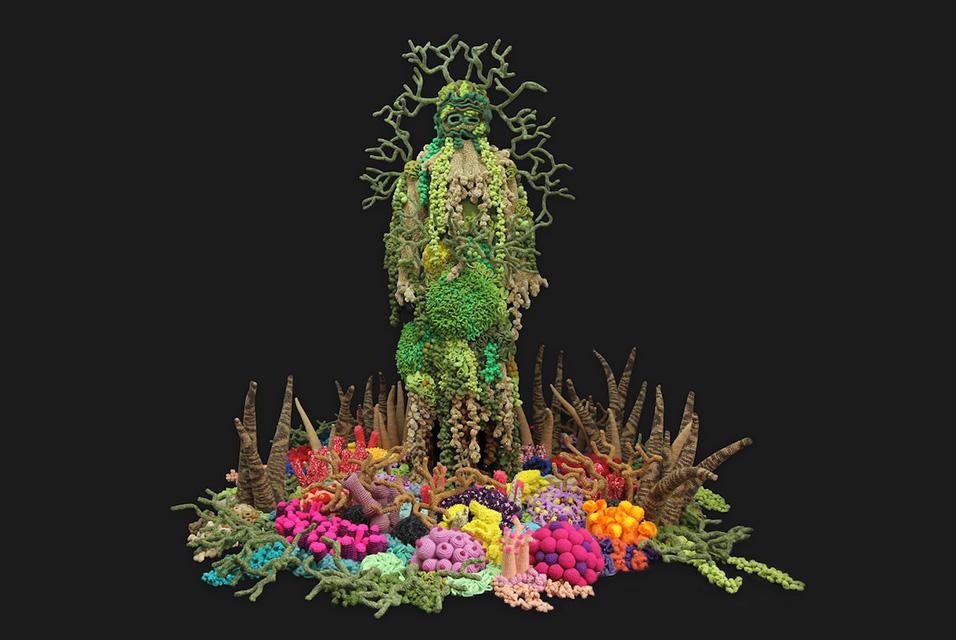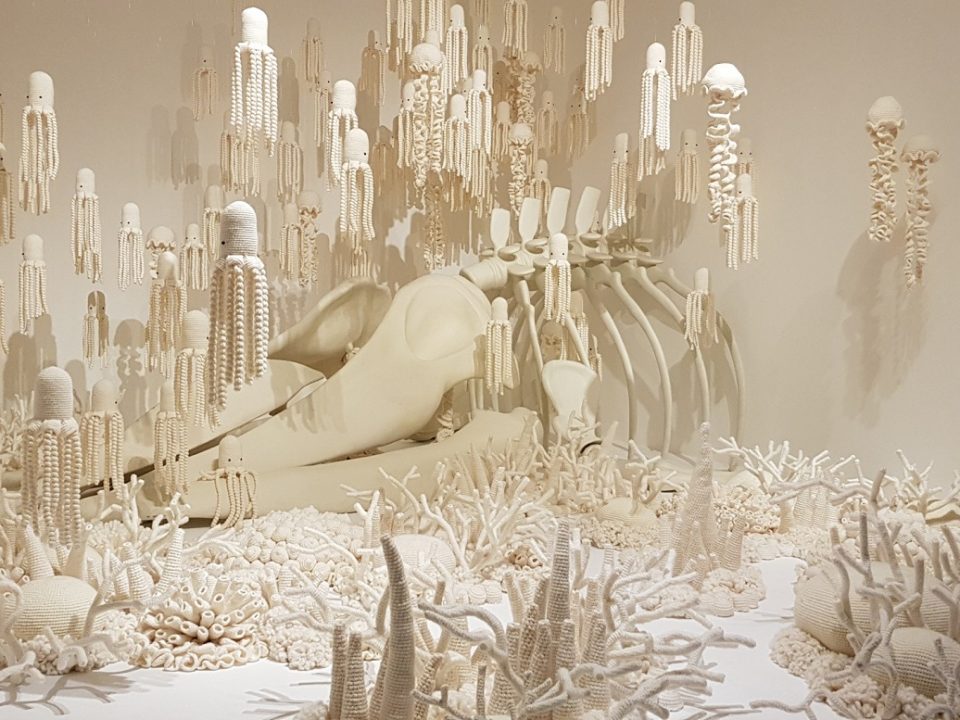
Mulyana’s first solo exhibition at Sapar Contemporary opens in New York
January 24, 2022
MULYANA: MODULAR UTOPIA
March 14, 2023What kind of energy do we want to have while fighting for the most important issues of our times?
Take ecology and environmental protection for example; do we want to fight for it by resorting to rage and indignation? As writers, curators, or artists tackling these themes, do we want to guilt audiences into becoming more eco-conscious? Or should our approach involve showing the beauty of what we are destroying, in order to elicit a desire to preserve and protect?
All these approaches are valid, and they work in tandem. For each fierce remark from Greta Thunberg, for each of Fiona Hall’s artworks that shocks us into realising what mankind is doing to the natural world, there are artists whose activism looks at the bright side.
There are some Indonesian artists who tend to look at the beauty and raise awareness of what we might lose, rather than the destruction already in progress. Such artists include Arahmaiani, whose performance works focus on harmony and respect for nature, and Jumaldi Alfi, who is renowned for his large-scale paintings that serve as re-readings of the Indonesian landscape.
Fragile Ecologies
Focusing on the wonders of nature is the premise for Bandung-born artist Mulyana’s latest exhibition Fragile Ecologies at Sapar Contemporary in New York. It ran earlier in the year from January 21 – March 4 and also marked his first solo show in the US.
“When I start making work, I can’t possibly calculate the kind of impact it will have on the public,” Mulyana says with a wide smile.
“What I do is simply share my vision of what I find beautiful about the natural and organic world.”
Fragile Ecologies features two life-size, hand-knit, and crocheted costumes, which the artist realized while being inspired by a number of folkloric traditions, Southeast Asian epics, stories and religious celebrations. The gallery’s main room also features a series of knit coral islands. Mulyana’s immersive installations captivate viewers with marvellous, detailed portrayals of ocean life. They also highlight the uncertain nature of complex ecosystems in the sea, which are menaced by rising global pollution levels and climate change.
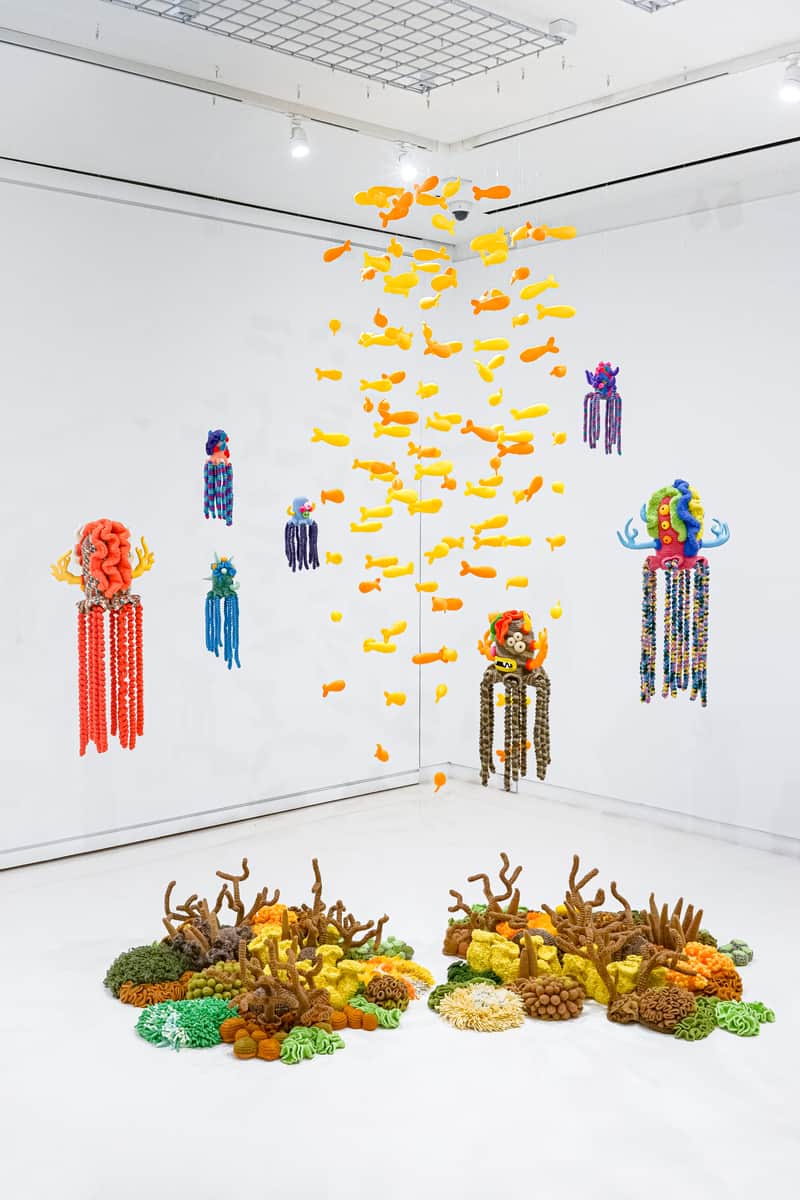
Fragile Ecologies Installation. 2022. Courtesy of Sapar Contemporary and the Artist
Works like Betty 9 are complex crocheted agglomerates. These sprawling works are completely white and are meant to be hung on the wall, evoking a still moment in time in the face of environmental destruction.

Betty 9. 2022. Mulyana. Courtesy of Sapar Contemporary and the Artist
Other pieces like Harmony 26, Harmony 23, and Harmony 24 also display precious aspects of the environment, but are much more colourful and playful.
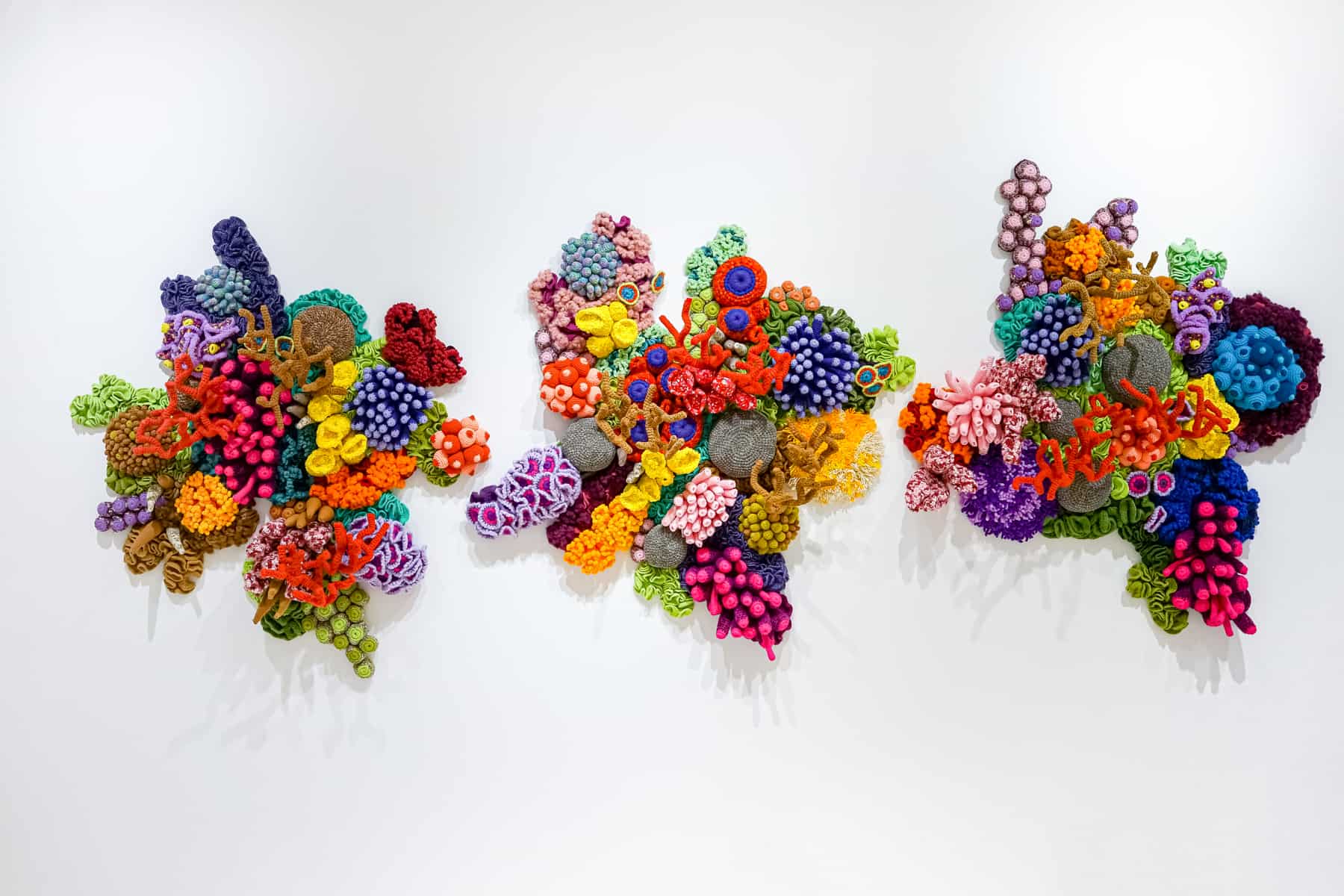
Harmony 26, Harmony 23, Harmony 24 (Left to right). 2021. Mulyana. Courtesy of Sapar Contemporary and the Artist.
The choice of the works for the show came from a series of discussions between the artist and curator John Silvis, which centred on Mulyana’s Mogus character. This monster-like figure merges the Gurita animal (octopus) with Mulyana’s family name (Sigarantang), and has been a symbol of Mulyana’s inner world since the beginning of his practice.
The show is part of Sapar Contemporary’s larger vision, with its Neo Nomad Incubator program aiming to bring prominent international artworks to the Western art world.
Community and Sustainability
There is a sincere enthusiasm when Mulyana speaks about his work and his intention of producing works on a larger scale, as I speak to him in Yogyakarta alongside Fragile Ecologies’ curator, New York-based John Silvis. The playful and joyous elements of Muluyana’s practice have much deeper roots. At the beginning of his art practice, Mulyana knitted his works by himself and viewed it as a meditation; a way to unite with a greater force animating the universe.
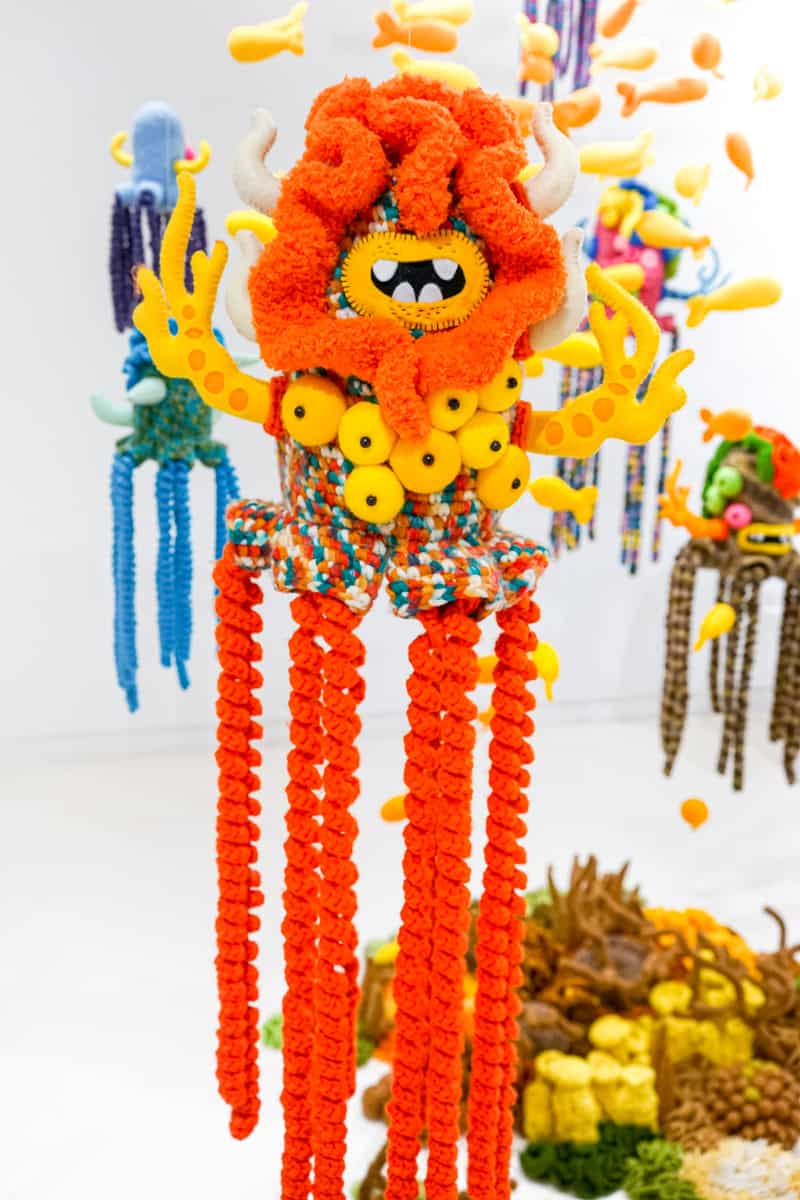
Mogus 94. 2021. Mulyana. Courtesy of Sapar Contemporary and the Artist
Today, Mulyana maintains this ethos but also shares it with all the collaborators who contribute to the creation of his large-scale artworks. These collaborators are mainly local artisans, with one of his first groups of collaborators being a community of transgender women in the village of Sorogenen in Yogyakarta. This reflects the artist’s dedication to inclusivity and collectivity in his practice.
In his commitment to sustainability, Mulyana uses recycled yarn to minimise the industrial production of new materials and to create worlds of fun characters inspired by the television shows of his youth. He started working with fabric because of his interest in Batik. “The Indonesian government made it mandatory for office workers and students to wear Batik on Fridays,” he says. On the fabric, he adds:
“I feel very special whenever I wear Batik. The fabric has many motifs, and its tactile nature is what attracted me to learn about and explore textiles.”
He started learning crochet in 2006, as he was interested in combining a meticulous approach with creativity to create patterns.
“Recycling is an integral part of making these works,” explains Mulyana. “In the beginning, I made works from the remains of the yarn making process. Today, I need more materials so I work with a factory that makes recycled yarn.”
He uses yarn from recycled waste materials from the fashion world, such as cotton, jeans, and cashmere. Organic yarns and natural fibres such as juta and soy are also important to his practice. He proves how artists can create incredible, scenic artworks, while also making sustainable choices and respecting the environment.
“The environment is a battle that we must come to join together (to fight for), and I feel this comes across also from the way Mulyana realises his works,” says John. “There is no way one can see these works and think they were made by an individual, just like we can’t save our planet alone.”
“The works have been realised with a very communal spirit, involving and teaching a number of people from Jogja, who can come and dedicate as much time as they can to contribute these incredibly knitting pieces,” he expounds.
Indonesian Roots
After completing his graduate degree in art education at the University Pendidikan Indonesia in Bandung in 2011, Mulyana moved to Yogyakarta in 2014 to investigate the possibility of community-based projects as an extension of his studio practice. He found that the communal spirit was the perfect environment to create works that were much bigger, and couldn’t be possibly realized by one person alone. The communal approach also brought in fresh ideas and energies that enriched the artist’s fantasy world.
“People in Indonesia say Bandung is the head, and Yogyakarta is the heart,” says Mulyana, alluding to the historically Western-style art teachings of Bandung, as compared to Jogja that plays home to art forms like traditional painting and performance.
During his time spent mostly in the two Indonesian cities, John Silvis had the chance to appreciate each city’s different artistic perspectives. He found that Mulyana’s methodical approach to crocheting perfectly synthesised these approaches by mixing creativity with a community-based practice.
In addition to that, he travelled across the region to Singapore, Thailand, and Vietnam, allowing John to identify the context that he thinks Mulyana’s work fits into.
“There are elements of storytelling and narrative in Mulyana’s work,” observes John, noting that the works recall cartoons and animation as well as works by pop surrealist artists Oky Rey Montha, Uji Hanan, and Iwan Effendi.
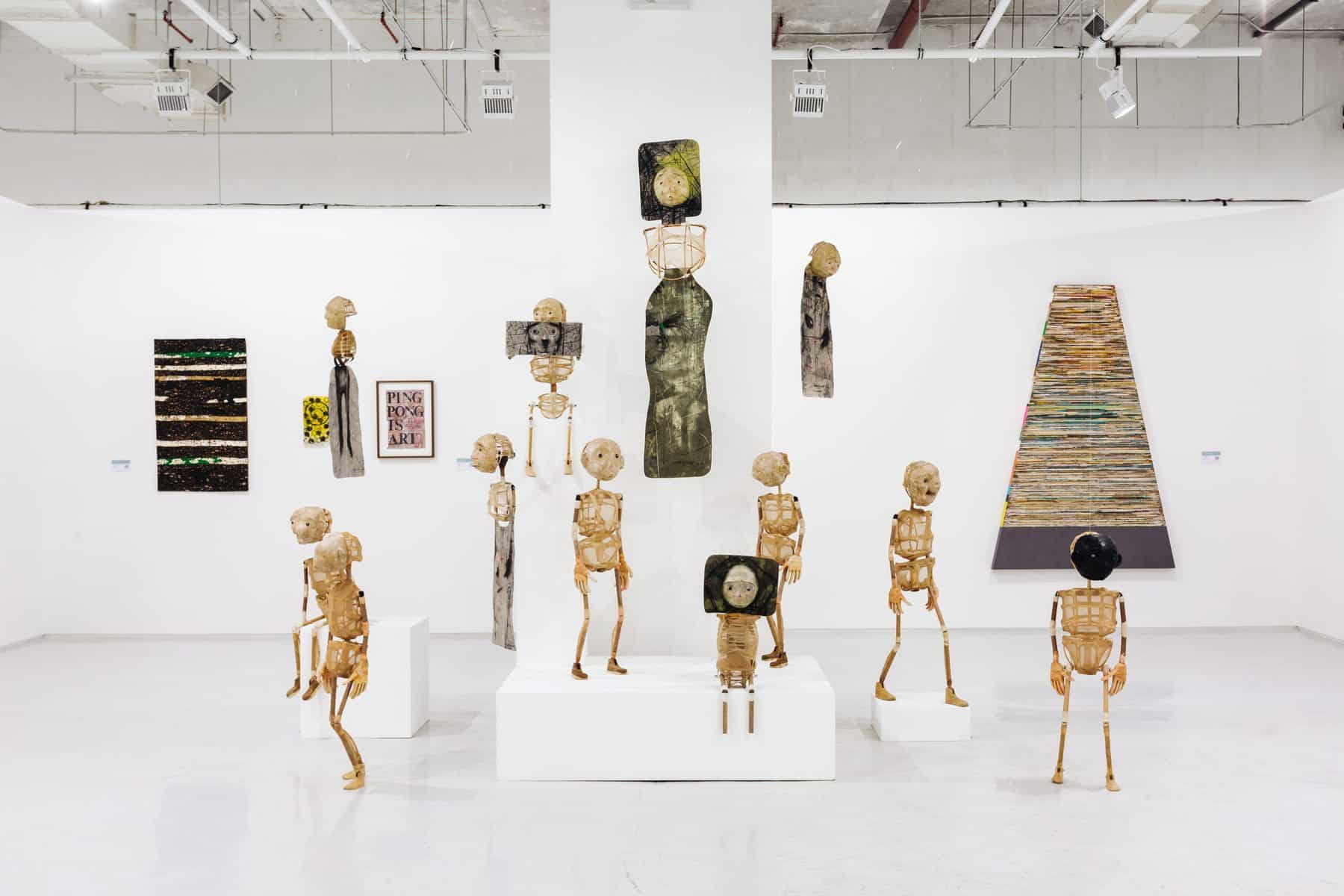
Effendi’s series The Visitor.Photo by Toni Cuhadi, courtesy of S.E.A. Focus, Singapore
John concludes:
“At the same time, Mulyana’s work is very unique in combining environmental engagement with playfulness. In this sense, it goes beyond the denunciation of environmental issues, and it becomes atemporal, poetic, relatable to everyone, everywhere.”
Exhibiting in New York City
Presenting Mulyana’s first solo show to the American public, John immediately viewed Mulyana’s works as avatars wearing masks and costumes and connected them to the political situation in the U.S. at the time and Trump’s prior presidency. While John’s presentation shifted away from ecological and aesthetic readings of Mulyana’s work, the exhibition was well-received by the public.
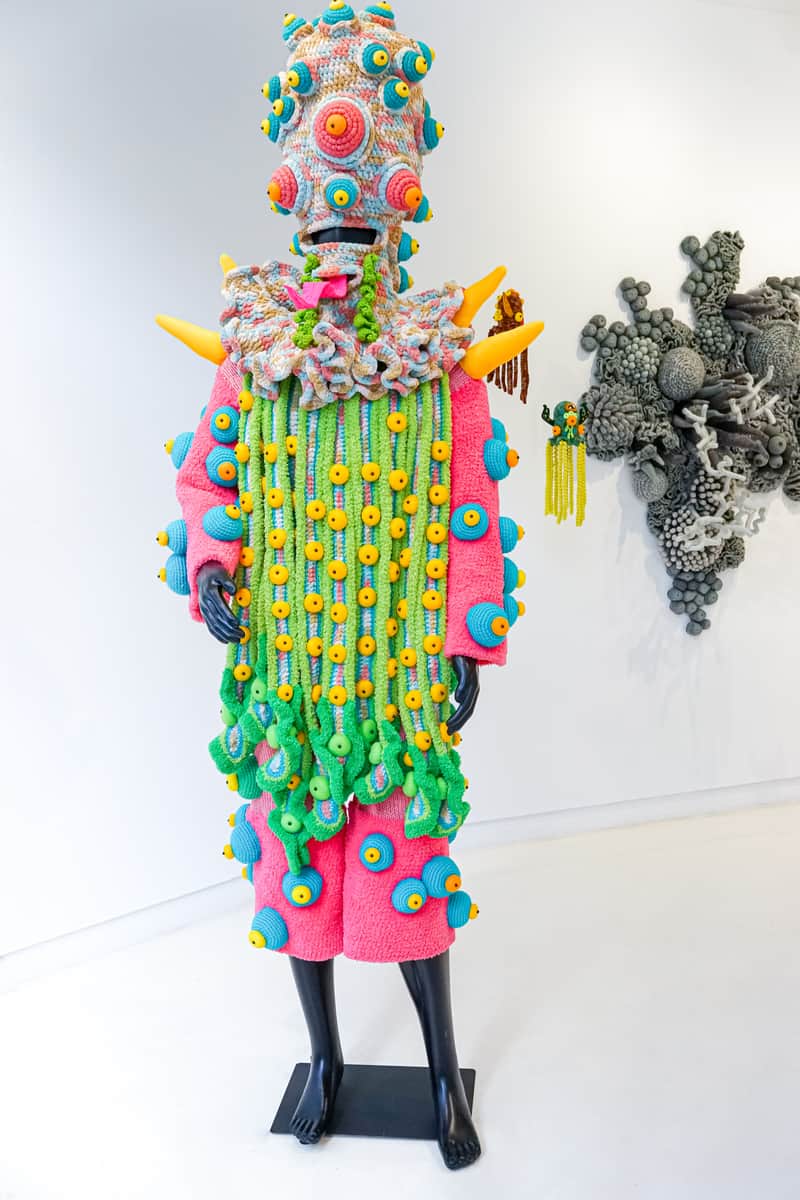
Nayanika. 2021. Mulyana. Courtesy of Sapar Contemporary and the Artist
He noted that the response from the public was overwhelmingly positive. “One repeated comment that I heard is ‘we are all in this together.’ The audience felt deeply connected to others in the environmental battle,” he shares.
“Unfortunately, so far art from the region hasn’t been widely showcased as Chinese or Japanese contemporary art has been. But everyone marvelled at the intricacy and just sheer beauty of Mulyana’s work,” he shared, adding that most visitors weren’t familiar with works by Southeast Asian artists.
“They were curious to learn more about the environmental issues he was talking about, and those that Indonesia is facing, like environmental pollution and mass tourism,” he continued. This made audiences think about the interconnectedness of the planet, their own countries’ environmental issues, and the responsibility for polluting countries overseas.

Small Mogus 18 . 2021. Mulyana. Courtesy of Sapar Contemporary and the Artist
Mulyana was hoping to travel to New York for the opening and perform with one of his costumes but was unable to due to the pandemic. What he did instead was to realise the performance in the form of a video shown as part of the exhibit. It showcased beautiful Indonesian landscapes and was filmed on location at Candi Plaosan, Candi Sewu, Gumuk Pasir and Situs Goa Siluman. Again, this was a collaboration with a local video maker and a friend musician who made the score — reflecting his dedication to working with the local community.
Looking Ahead
“My new work will be focused on the concept of ‘the good monster.’ It comes from my experience of 14 days of quarantine in Incheon, South Korea, upon my arrival for my residence with Cheongju Craft Biennale. This experience – which was generally a negative one – was turned into inspiration for my work,” says Mulyana. “I will make knitted works of the food I was eating, and it will be called Bento, please cheer me up.”
He shares that the series will consist of 42 pieces, representing 3 meals a day for 14 days. They will be presented at ARTJOG this summer. After that, Mulyana will show his series Ghost Net, which will focus on ghosts, mythology, and the environment. This will take place in October at the art space SaRang Building in Yogyakarta.
“One thing I see in Mulyana’s work and why it’s so unique is that when we look at it we never feel discouraged or dulled down by a glooming destiny of destruction of mankind,” concludes John. “In its playfulness and seriousness, we can’t look away from how beautiful the world is. And this beauty is worth protecting and fighting for.”
____________________________________
Mulyana’s full set Food Monsters will be part of ARTJOG MMXXII from 26 July – 4 Sept 2022.
The artist’s solo exhibition Ghost Net will be in SaRang Building 5-28 October 2022.
Source: pluralartmag.com

